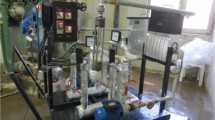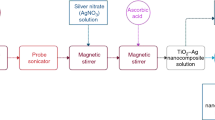Abstract
This study is about the performance evaluation of a shell and tube heat exchanger operated with nanofluid. Thermal conductivity, viscosity, and density of the nanofluids were increased, but the specific heat of the nanofluids was decreased with increasing the concentrations of the particles. The convective heat transfer coefficient was found to be 2–15 % higher than that of water at 50 kg/min of both side fluid. Nevertheless, energy effectiveness has improved about 23–52 % for the above-mentioned nanofluids. As, energy effectiveness (ɛ) is strongly depends on the density and specific heat of the operating fluids therefore, maximum ɛ has obtained for ZnO–W nanofluid and lowest found for SiO2–W nanofluid.








Similar content being viewed by others
Abbreviations
- A :
-
Area (m2)
- A cf :
-
Cross flow area (m2)
- C :
-
Heat capacity rate
- C p :
-
Specific heat capacity (J/kg K)
- C r :
-
Heat capacity ratio
- D :
-
Dia of shell (m)
- D :
-
Dia of tube (m)
- K :
-
Thermal conductivity (W/m K)
- L :
-
Length (m)
- \(\dot{m}_{f}\) :
-
Mass flow rate of base fluid (kg/s)
- \(\dot{m}_{nf}\) :
-
Mass flow rate of nano fluid (kg/s)
- N :
-
Number of tubes
- NTU :
-
Number of heat transfer units
- Nu :
-
Nusselt number
- Pr:
-
Prandtl number
- Re:
-
Reynolds number
- U o :
-
Overall heat transfer coefficient (W/m2 K)
- W:
-
Water
- µ :
-
Viscosity (Ns/m2)
- Ø :
-
Volume fraction
- ɛ :
-
Energy effectiveness
- ρ :
-
Density (kg/m3)
- n f :
-
Nanofluid
- f :
-
Base fluid
- n p :
-
Nanoparticle
- h :
-
Hot side
- c :
-
Cold side
- fs :
-
Shell side fluid
- f T :
-
Tube side fluid
- w :
-
Wall
- min:
-
Minimum
- max:
-
Maximum
References
Choi S (1995) Enhancing thermal conductivity of fluids with nanoparticles. In: Siginer DA, Wang HP (eds) Developments applications of non-newtonian flows, FED-vol 231/MD-vol 66. ASME, New York, pp 99–105
LotfizadehDehkordi B et al (2013) Investigation of viscosity and thermal conductivity of alumina nanofluids with addition of SDBS. Heat Mass Transf 49(8):1109–1115
Mahbubul IM, Saidur R, Amalina MA (2012) Latest developments on the viscosity of nanofluids. Int J Heat Mass Transf 55(4):874–885
Sundar LS et al (2013) Experimental thermal conductivity of ethylene glycol and water mixture based low volume concentration of Al2O3 and CuO nanofluids. Int Commun Heat Mass Transf 41:41–46
Rizvi I et al (2013) Mathematical modelling of thermal conductivity for nanofluid considering interfacial nano-layer. Heat Mass Transf 49(4):595–600
Keblinski P, Eastman JA, Cahill DG (2005) Nanofluids for thermal transport. Mater Today 8(6):36–44
Mahbubul IM, Saidur R, Amalina MA (2013) Thermal conductivity, viscosity and density of R141b refrigerant based nanofluid. Proced Eng 56:310–315. doi:10.1016/j.proeng.2013.03.124
Vasheghani M et al (2011) Effect of Al2O3 phases on the enhancement of thermal conductivity and viscosity of nanofluids in engine oil. Heat Mass Transf 47(11):1401–1405
Pandey SD, Nema VK (2012) Experimental analysis of heat transfer and friction factor of nanofluid as a coolant in a corrugated plate heat exchanger. Exp Thermal Fluid Sci 38:248–256
Zhou S-Q, Ni R (2008) Measurement of the specific heat capacity of water-based Al2O3 nanofluid. Appl Phys Lett 92(9):093123
Shahrul IM et al (2014) Effectiveness study of a shell and tube heat exchanger operated with nanofluids at different mass flow rates. Numer Heat Transf Part A Appl 65(7):699–713
Namburu PK et al (2009) Numerical study of turbulent flow and heat transfer characteristics of nanofluids considering variable properties. Int J Therm Sci 48(2):290–302
Vakili M, Mohebbi A, Hashemipour H (2013) Experimental study on convective heat transfer of TiO2 nanofluids. Heat Mass Transf 49(8):1159–1165
Heris SZ, Esfahany MN, Etemad SG (2007) Experimental investigation of convective heat transfer of Al2O3/water nanofluid in circular tube. Int J Heat Fluid Flow 28(2):203–210
Hajmohammadi MR et al (2015) Effects of Cu and Ag nano-particles on flow and heat transfer from permeable surfaces. Adv Powder Technol 26:193–199
Hajmohammadi MR et al (2013) A new configuration of bend tubes for compound optimization of heat and fluid flow. Energy 62:418–424
Hajmohammadi M, Nourazar SS, Campo A (2014) Analytical solution for two-phase flow between two rotating cylinders filled with power law liquid and a micro layer of gas. J Mech Sci Technol 28(5):1849–1854
Hajmohammadi MR, Nourazar SS (2014) On the insertion of a thin gas layer in micro cylindrical Couette flows involving power-law liquids. Int J Heat Mass Transf 75:97–108
Hojjat M et al (2011) Laminar convective heat transfer of non-Newtonian nanofluids with constant wall temperature. Heat Mass Transf 47(2):203–209
Suresh S, Chandrasekar M, Selvakumar P (2012) Experimental studies on heat transfer and friction factor characteristics of CuO/water nanofluid under laminar flow in a helically dimpled tube. Heat Mass Transf 48(4):683–694
Elias MM et al (2014) Effect of different nanoparticle shapes on shell and tube heat exchanger using different baffle angles and operated with nanofluid. Int J Heat Mass Transf 70:289–297
Farajollahi B, Etemad SG, Hojjat M (2010) Heat transfer of nanofluids in a shell and tube heat exchanger. Int J Heat Mass Transf 53(1–3):12–17
Lotfi R, Rashidi AM, Amrollahi A (2012) Experimental study on the heat transfer enhancement of MWNT-water nanofluid in a shell and tube heat exchanger. Int Commun Heat Mass Transf 39(1):108–111
BHD., S.E.S. HIS Shell & Tube Heat Exchanger (Model: HE 668). 2011 17/06/2011; 17/06/2011. http://www.solution.com.my/pdf/HE668(A4).pdf
Hajmohammadi MR, Nourazar SS (2014) On the solution of characteristic value problems arising in linear stability analysis; semi analytical approach. Appl Math Comput 239:126–132
Sarkar J (2011) A critical review on convective heat transfer correlations of nanofluids. Renew Sustain Energy Rev 15(6):3271–3277
Gafiychuk VV et al (2011) ZnO nanoparticles produced by reactive laser ablation. Appl Surf Sci 257(20):8396–8401
Sundar LS et al (2012) Effect of full length twisted tape inserts on heat transfer and friction factor enhancement with Fe3O4 magnetic nanofluid inside a plain tube: an experimental study. Int J Heat Mass Transf 55(11–12):2761–2768
Kamyar A, Saidur R, Hasanuzzaman M (2012) Application of computational fluid dynamics (CFD) for nanofluids. Int J Heat Mass Transf 55(15–16):4104–4115
Vajjha RS, Das DK (2009) Specific heat measurement of three nanofluids and development of new correlations. ASME J Heat Transf 131(7):071601
Incropera FP et al (2007) Fundamentals of heat and mass transfer, 6th edn. Wiley, New Jersey
Leong KY et al (2012) Modeling of shell and tube heat recovery exchanger operated with nanofluid based coolants. Int J Heat Mass Transf 55(4):808–816
Kakac S, Pramuanjaroenkij A, Liu H (2012) Heat exchangers: selection, rating, and thermal design, 3rd edn. CRC Press, FL
Shah RK, Sekulic DP (2003) Fundamentals of heat exchanger design. Wiley, New Jersey
Xuan Y, Roetzel W (2000) Conceptions for heat transfer correlation of nanofluids. Int J Heat Mass Transf 43(19):3701–3707
Pak BC, Cho YI (1998) Hydrodynamic and heat transfer study of dispersed fluids with submicron metallic oxide particles. Exp Heat Transf 11(2):151–170
Brinkman H (1952) The viscosity of concentrated suspensions and solutions. J Chem Phys 20:571
Leong KC, Yang C, Murshed SMS (2006) A model for the thermal conductivity of nanofluids—the effect of interfacial layer. J Nanopart Res 8(2):245–254
Einstein A, Fürth R (1956) Investigations on the theory of Brownian movement. Dover Publications, New York
Teng T-P et al (2010) The effect of alumina/water nanofluid particle size on thermal conductivity. Appl Therm Eng 30(14–15):2213–2218
Ghozatloo A, Rashidi A, Shariaty-Niassar M (2014) Convective heat transfer enhancement of graphene nanofluids in shell and tube heat exchanger. Exp Thermal Fluid Sci 53:136–141
Nasiri M, Etemad SG, Bagheri R (2011) Experimental heat transfer of nanofluid through an annular duct. Int Commun Heat Mass Transf 38(7):958–963
Elias MM et al (2013) Effect of nanoparticle shape on the heat transfer and thermodynamic performance of a shell and tube heat exchanger. Int Commun Heat Mass Transf 44:93–99
Leong KY et al (2012) Heat transfer and entropy analysis of three different types of heat exchangers operated with nanofluids. Int Commun Heat Mass Transf 39(6):838–843
Shahrul IM et al (2014) Global effects of MWCNT-W nanofluid in a shell & tube heat exchanger. Adv Mater Res 832:154–159
Shahrul IM et al (2014) Energy and environmental effects of shell and tube heat exchanger by using nanofluid as a coolant. J Chem Eng Jpn 47(4):340–344
Hajmohammadi MR et al (2013) New methods to cope with temperature elevations in heated segments of flat plates cooled by boundary layer flow. Therm Sci 00:159
Bejan A, Sciubba E (1992) The optimal spacing of parallel plates cooled by forced convection. Int J Heat Mass Transf 35(12):3259–3264
Hajmohammadi MR et al (2013) Improvement of forced convection cooling due to the attachment of heat sources to a conducting thick plate. J Heat Transf 135(12):124504
Acknowledgements
The authors would like to acknowledge Ministry of Education Malaysia (MoE) Malaysia for financial support. This work was supported by UM-MoE High Impact Research Grant Scheme (HIRG) (Project No: UM.C/HIR/MOHE/ENG/40 (D000040-16001)).
Author information
Authors and Affiliations
Corresponding author
Rights and permissions
About this article
Cite this article
Shahrul, I.M., Mahbubul, I.M., Saidur, R. et al. Performance evaluation of a shell and tube heat exchanger operated with oxide based nanofluids. Heat Mass Transfer 52, 1425–1433 (2016). https://doi.org/10.1007/s00231-015-1664-6
Received:
Accepted:
Published:
Issue Date:
DOI: https://doi.org/10.1007/s00231-015-1664-6




